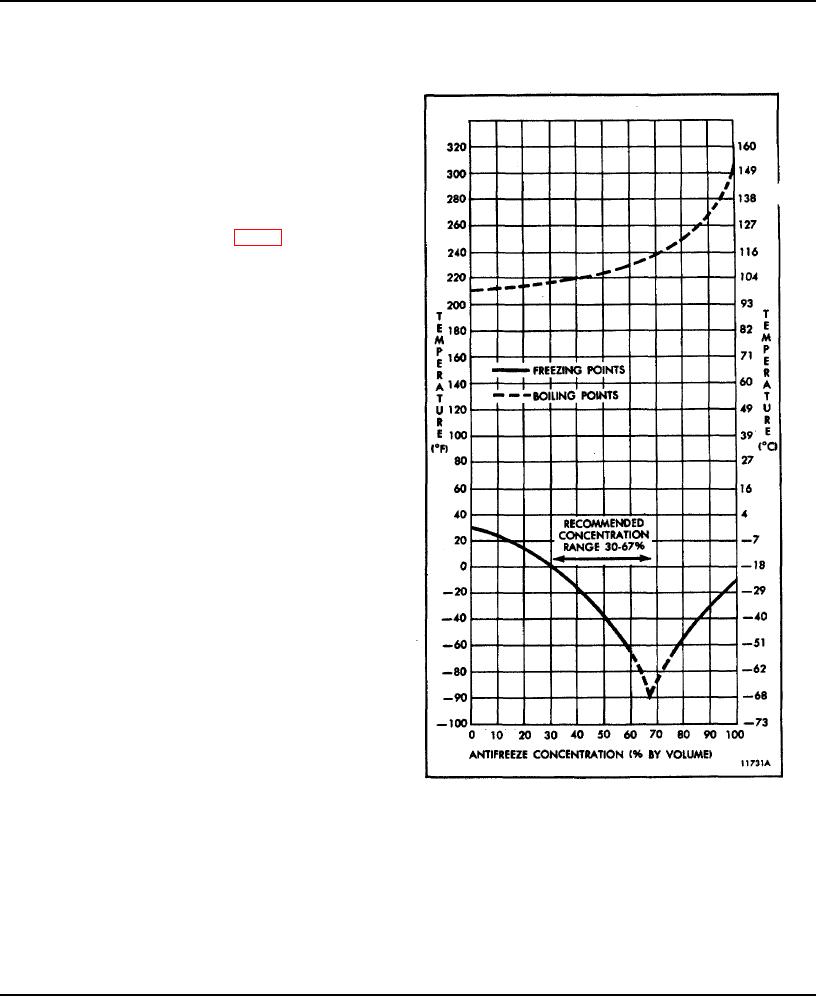
Fuel, Oil and Coolant Specifications
Always follow the supplier's recommendations on inhibitor usage and handling.
NOTE: Methoxy Propanol base permanent antifreeze (such as Dowtherm 209, or
equivalent) must be re-inhibited only with compatible corrosion inhibitor systems.
ANTIFREEZE
When freeze protection is required, a permanent antifreeze
must be used. An inhibitor system is included in this type
of antifreeze and no additional inhibitors are required on
initial fill if a minimum antifreeze concentration of 30% by
volume is used. Solutions of less than 30%, concentration
do
not
provide
sufficient
corrosion
protection.
Concentrations over 67% adversely affect freeze
protection and heat transfer rates (Fig. 4).
Methoxy Propanol base antifreeze is not recommended for
use in Detroit Diesel engines due to the presence of
fluoroelastomer (Viton '0') seals in the cooling system.
Before installing ethylene glycol base anti-freeze in an
engine previously operated with Methoxy Propanol, the
entire cooling system should be drained, flushed with clean
water and examined for rust, scale, contaminants, etc. If
deposits are present, the cooling
system must be chemically cleaned with a commercial
grade heavy-duty de-scaler.
Ethylene glycol base antifreeze is recommended for use in
Detroit Diesel engines. Methyl alcohol antifreeze is not
recommended because of its effect on the non-metallic
components of the cooling system and because of its low
boiling point.
The inhibitors in permanent antifreeze should be
replenished at approximately 500 hour or 20,000 mile
intervals with a non-chromate inhibitor system.
Commercially available inhibitor systems may be used to
re-inhibit antifreeze solutions.
Sealer Additives
Several brands of permanent antifreeze are available with
sealer additives. The specific type of sealer varies with the
manufacturer. Antifreeze with sealer additives is not
recommended for use in Detroit Diesel engines due to
possible plugging throughout various areas of the cooling
system.
GENERAL RECOMMENDATIONS
All Detroit Diesel engines incorporate pressurized cooling systems which normally operate at temperatures higher than
non-pressurized systems. It is essential that these systems be kept clean and leak-free, that filler caps and pressure
relief mechanisms be correctly installed at all times and that coolant levels be properly maintained.
WARNING: Use extreme care when removing a radiator pressure control cap from an
engine. The sudden release of pressure from a heated cooling system can result in a
loss of coolant and possible personal injury (scalding) from the hot liquid.
1. Always use a properly inhibited coolant.
Page 74

